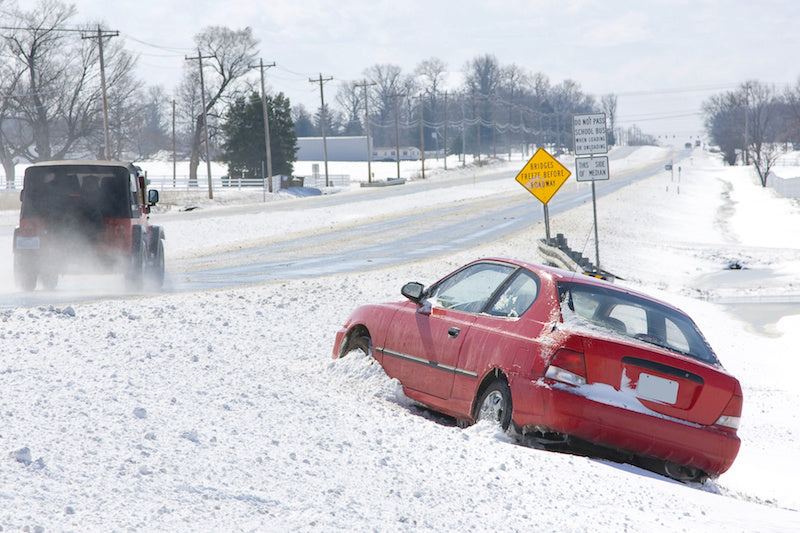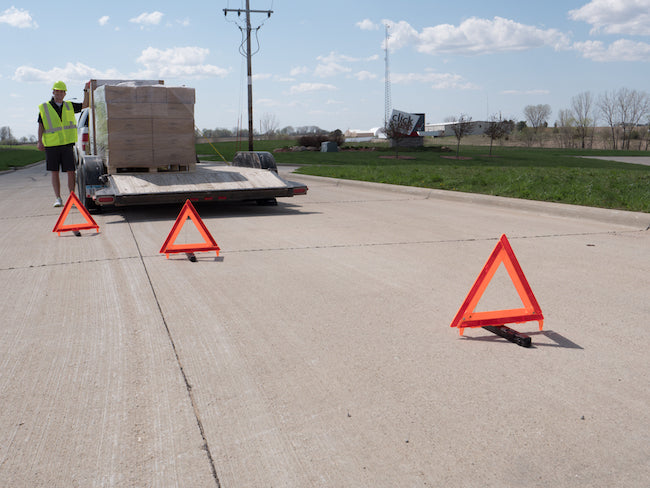
How to Pull a Car Out of Snow Using a Recovery Strap
Recovery straps can be used all year long, but they are especially handy in the winter months, when roadsides become flooded with spun-out vehicles. The best way to get a car out of snow quickly (without the cost of a professional tow truck) is by rigging a recovery strap to a tow hook or recovery point on the vehicle and slowly dragging it out. Between the type of vehicle, weather conditions, and distance from the roadway, there are many variables that make each vehicle recovery situation different.
Use the steps below as a general guideline for how to pull a car out of the snow, but know your limits and never push the capabilities of your vehicle or yourself.
6 Steps for Recovering a Vehicle from Snow Using Recovery Straps

1. Make Yourself Visible to Others
- Browse through our selection of Vehicle Safety Supplies today!
2. Make the Recover Process as Easy as Possible
Sometimes, stuck vehicles in the snow can get really buried in. Instead of trying to pull it out from this mess, make it easier on your recovery straps and recovery vehicle by shoveling the snow away from the stuck vehicle, including the tires and the undercarriage. You can also put sand or kitty litter under the tires to create some traction and ease the strain on the strap, making the pull a whole lot easier.
3. Secure the Recovery Strap to the Vehicle
Next, attach the strap to the rear of the towing vehicle, somewhere with plenty of structural support like a trailer hitch with steel loops for mounting a tow hook or a shackle. Anchor shackles are one of the best and safest ways to secure a recovery strap. Refer to your vehicle's owner's manual for guidance on safe strap rigging.
Never attach the strap to a trailer hitch ball. This can cause bending and breaking which could result in serious injury. You should also make sure the strap you're using is rated high enough. A good rule of thumb is for the vehicle weight to be half the break strength of the strap.

4. Secure Strap to the Stuck Vehicle
Similarly, you need to attach the other end of the recovery strap to the stuck vehicle. As a reminder, never attach a recovery strap to the bumper, axle, suspension, or steering rods of a vehicle. Pulling on these components causes significant damage to the vehicle as a whole, as they are not made to handle this tension.
Before resorting to hooking onto the frame, check the front bumper for a small square section of the plastic that is removable. Many newer vehicles contain removable tow hooks or towing eyes stored with the car's jack. Insert these components to the identified places on the vehicle and hook the recovery straps on them.
If you're lucky enough to be pulling a vehicle with clearly visible tow hooks, secure the strap to those. Many smaller vehicles and newer model cars don't have the best tow hooks, or they are often hidden. When pulling, lay a tarp or some jackets on top of the strap to slow the recoil of the strap if it were to break.
- Browse through our tarps today!
5. Reduce Slack, Then Pull Slowly
Once the strap is safely secured, the recovery vehicle should slowly pull forward to reduce strap slack and prevent snapping. Then, with drivers in both vehicles and no people near the strap, the recovery vehicle can start accelerating slowly and gradually. The recovered vehicle should be in gear and once they're moving the driver should apply some gas and steer the vehicle out.
6. Inspect Equipment and Get Home Safe
Pull the car out of the snow and back on drivable land. After that, inspect your recovery strap and all hardware before heading home. Clean the strap when you get home and store it in a dry and cool place.
Why Use Recovery Straps Over Tow Straps?
Make sure to use recovery straps for stuck vehicles and not tow straps. Recovery straps stretch more than tow straps that prevents it from snapping when tugging on the vehicle. Recovery straps also provide a more controlled pull compared to the tow straps. Without getting too scientific, the stored kinetic energy from the strap stretches then recoils back to its natural length. This provides control and prevents the strap from snapping.
Recovery Straps from US Cargo Control
US Cargo Control's heavy-duty recovery straps are designed to make rescuing your vehicle simple and reliable. We offer these products in a variety of lengths, sizes, and plies to accommodate different vehicle types, including:
- Heavy Duty ATV/UTV Recovery Straps (up to 2,000 lbs.)
- Car Recovery Straps (up to 10,000 lbs.)
- Semi-Truck Recovery Straps (up to 80,000 lbs.)
- Heavy Equipment Recovery Straps (over 80,000 lbs.)
More Articles You May Like:
11 Tips to Safely Extract Stuck Tractors and Farm Equipment from Mud
Heavy Duty Towing vs. Light Duty Towing: What's the Difference?
Recover Vehicles with 3-Ply & 4-Ply Recovery Straps
Which Car Tie Down Strap is Right for Me?
Winter Truck Maintenance: 10 Tips to Prepare Your Truck for Winter



